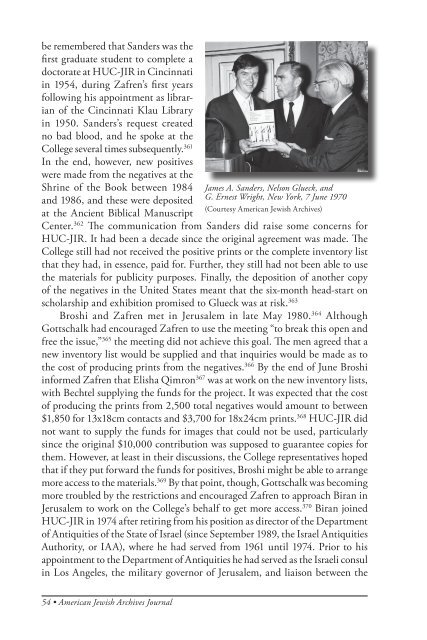The American Jewish Archives Journal, Volume LXI 2009, Number 1
The American Jewish Archives Journal, Volume LXI 2009, Number 1
The American Jewish Archives Journal, Volume LXI 2009, Number 1
You also want an ePaper? Increase the reach of your titles
YUMPU automatically turns print PDFs into web optimized ePapers that Google loves.
e remembered that Sanders was the<br />
first graduate student to complete a<br />
doctorate at HUC-JIR in Cincinnati<br />
in 1954, during Zafren’s first years<br />
following his appointment as librarian<br />
of the Cincinnati Klau Library<br />
in 1950. Sanders’s request created<br />
no bad blood, and he spoke at the<br />
College several times subsequently. 361<br />
In the end, however, new positives<br />
were made from the negatives at the<br />
Shrine of the Book between 1984<br />
and 1986, and these were deposited<br />
at the Ancient Biblical Manuscript<br />
Center. 362 <strong>The</strong> communication from Sanders did raise some concerns for<br />
HUC-JIR. It had been a decade since the original agreement was made. <strong>The</strong><br />
College still had not received the positive prints or the complete inventory list<br />
that they had, in essence, paid for. Further, they still had not been able to use<br />
the materials for publicity purposes. Finally, the deposition of another copy<br />
of the negatives in the United States meant that the six-month head-start on<br />
scholarship and exhibition promised to Glueck was at risk. 363<br />
Broshi and Zafren met in Jerusalem in late May 1980. 364 Although<br />
Gottschalk had encouraged Zafren to use the meeting “to break this open and<br />
free the issue,” 365 the meeting did not achieve this goal. <strong>The</strong> men agreed that a<br />
new inventory list would be supplied and that inquiries would be made as to<br />
the cost of producing prints from the negatives. 366 By the end of June Broshi<br />
informed Zafren that Elisha Qimron 367 was at work on the new inventory lists,<br />
with Bechtel supplying the funds for the project. It was expected that the cost<br />
of producing the prints from 2,500 total negatives would amount to between<br />
$1,850 for 13x18cm contacts and $3,700 for 18x24cm prints. 368 HUC-JIR did<br />
not want to supply the funds for images that could not be used, particularly<br />
since the original $10,000 contribution was supposed to guarantee copies for<br />
them. However, at least in their discussions, the College representatives hoped<br />
that if they put forward the funds for positives, Broshi might be able to arrange<br />
more access to the materials. 369 By that point, though, Gottschalk was becoming<br />
more troubled by the restrictions and encouraged Zafren to approach Biran in<br />
Jerusalem to work on the College’s behalf to get more access. 370 Biran joined<br />
HUC-JIR in 1974 after retiring from his position as director of the Department<br />
of Antiquities of the State of Israel (since September 1989, the Israel Antiquities<br />
Authority, or IAA), where he had served from 1961 until 1974. Prior to his<br />
appointment to the Department of Antiquities he had served as the Israeli consul<br />
in Los Angeles, the military governor of Jerusalem, and liaison between the<br />
54 • <strong>American</strong> <strong>Jewish</strong> <strong>Archives</strong> <strong>Journal</strong><br />
James A. Sanders, Nelson Glueck, and<br />
G. Ernest Wright, New York, 7 June 1970<br />
(Courtesy <strong>American</strong> <strong>Jewish</strong> <strong>Archives</strong>)

















